Training guide
| Site: | OpenLearn Create |
| Course: | Active teaching and learning for Africa (5): Supporting literacy across the curriculum |
| Book: | Training guide |
| Printed by: | Guest user |
| Date: | Friday, 21 November 2025, 3:43 PM |
Table of contents
- 1. Introduction
- 2. The importance of literacy
- 3. Supporting reading and writing through active teaching and learning
- 4. Supporting reading and writing across different subjects
- 5. Supporting reading and writing across different levels
- 6. Encouraging your learners to read
- 7. Summary: Literacy across the curriculum
1. Introduction
Welcome back!
This enhanced SPRINT programme offers resources and suggestions to develop more active teaching approaches and to work more collaboratively with peers.
This programme is designed to support active teaching and learning in line with the revised Zambian school curriculum. The programme provides resources for six terms (two school years), and the current resources focus on supporting literacy across the curriculum. The resources will be the focus of your Teacher Group Meetings (TGMs) and provide ideas for collaboration, planning, discussion and reflection among teachers.
In Year 1, you covered nine teaching approaches in the three courses.
Course 1: Classroom management for learner-centred teaching
- using questioning to promote thinking
- using pair work
- using the local community/environment as a resource.
Course 2: Inclusive teaching
- using group work in your classroom
- storytelling, songs, games and role-play
- involving all learners.
Course 3: Assessment for learning
- monitoring and giving feedback
- eliciting prior knowledge
- assessing learning.
In Year 2, the aim is to consolidate this learning by focusing on:
- Course 1: Managing and supporting learner-centred classrooms.
- Course 2: Supporting literacy across the curriculum.
- Course 3: Being a reflective practitioner.
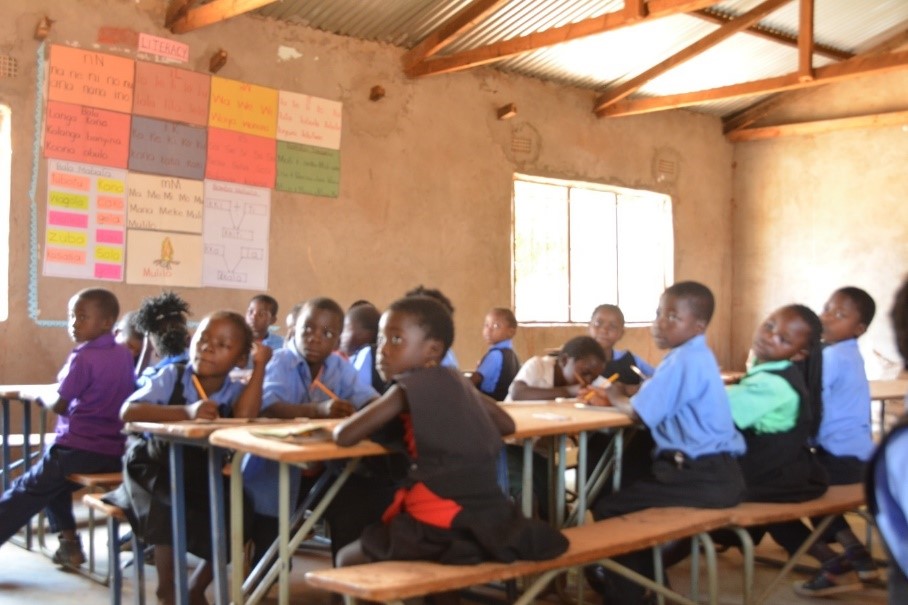
Literacy lesson in a print-rich classroom.
Supporting learners’ reading and writing skills is everyone’s responsibility. Being able to read and write fluently is very important as it will help learners in ALL subjects. Supporting literacy doesn’t only have to take place in literacy lessons – all teachers can do it, whatever subject they are teaching.
The resources in this course are presented in three sections:
- supporting reading and writing through active teaching and learning
- supporting reading and writing across different subjects
- supporting reading and writing across different levels.
The activities in these resources are designed for you to try in TGMs and then to do with your class. The classroom examples will give you some ideas to adapt for your class. They all provide examples of how the different teaching approaches you focused on and developed last year can support literacy. You will find more examples in the TESSA modules you started using in course 4. It is important that you continue to work with colleagues and discuss with them how you could adapt them for different classes.
The aim of these training resources is not to show you how to teach literacy, but to give ideas on how you can support literacy across the curriculum in all your classrooms. It is a good idea to keep a separate section of your Teacher Notebook where you write down any ideas you have and activities you try for supporting literacy and share them with your colleagues in the TGMs.
2. The importance of literacy
Learning to read and write in primary school is an essential foundation for a successful education. A good education can make a huge difference to a person’s whole life. Learning to read and write well, however, takes a lot of practice. It is important to give your learners regular reading and writing practice so they can build their skills and confidence and improve their learning in all subjects and grades.
In order to access the subject curriculum, learners need to be able to read. The TGM resources that you are using this term are based on the assumption that it is all teachers’ responsibility to support literacy. There are many strategies, based on the nine teaching approaches, that you can use in your subject teaching which will help students both learn your subject and develop their skills in literacy.
Classroom Example 5.1: Supporting literacy as a whole school
Listen to the audio or read the transcript for Classroom Example 5.1. In your Teacher Notebook, make a note of the different initiatives Egerton Primary School took to support literacy. Audio transcript: In 2008, Egerton Primary School teachers in Kenya were introduced to the TESSA resources. Working together, they decided to make some changes in their school. They organised the desks into groups rather than rows, so learners could work together in pairs and groups. As they started to use more active approaches to learning and teaching, they noticed that some of the children in Grade 4 were struggling with their work in social studies and science because they could not read very well. Working together, they put a big emphasis on literacy. They created a space in the school for a library. A group of parents came in and helped to build some shelves. The Head Teacher turned to the local Church, national and international charities, and with their help managed to build a collection of reading books. They used the African Storybook website to find and print stories in the local languages. Younger children had timetabled sessions in the new library and teachers from all subjects worked together to support literacy. Social studies and science teachers looked at the TESSA literacy resources and adapted some of the activities to teach their subject. There was much excitement around the new library and over time teachers found that children became more confident and enthusiastic readers. One of the teachers set up a scheme where the stronger readers were encouraged to read with those who were less confident during breaks and lunchtimes. |
Activity 5.1: Supporting literacy
After listening to/reading the classroom example, in the TGM identify the steps Egerton Primary School took to support literacy. As a group, discuss literacy in your own school.
Is there anything that you can take from this example? In your Teacher Notebook, write:
You can make a poster of the three school actions to put in the staff room as a reminder for all teachers that literacy is everyone’s responsibility and to ensure you fulfil the actions by the end of term. |
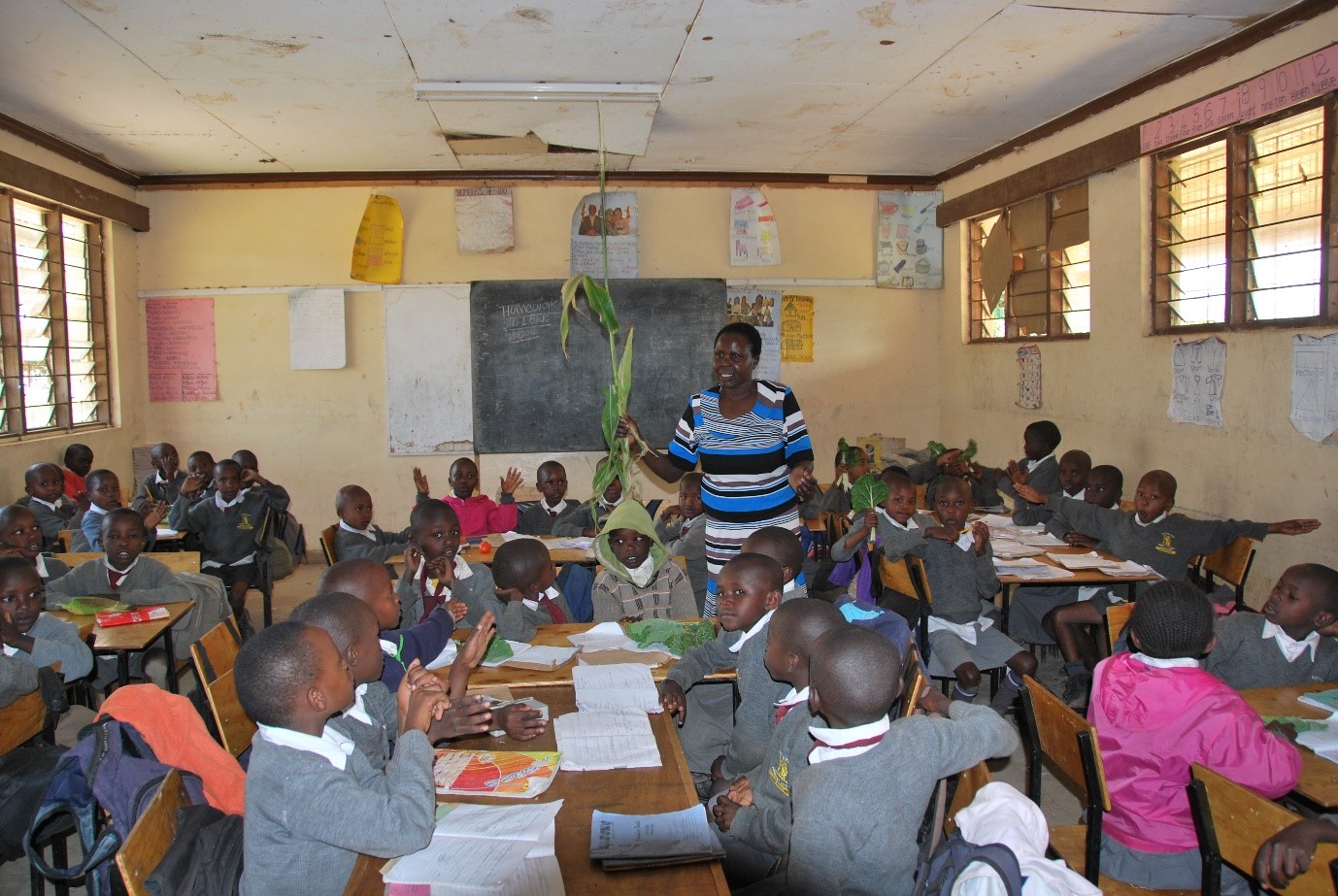
A Primary School in Kenya
3. Supporting reading and writing through active teaching and learning
In the course 1 training materials, one of the topics was on using questioning to promote thinking But questioning can also be useful in helping learners with their reading skills. When children are learning to read, asking questions helps them to understand the general characteristics of the text they are reading (e.g. what is the story about?) and the information in the text (e.g. why was the lion sad? what did the zebra say to the lion?). It also helps the teacher to know how successfully learners have been able to read the text. Of course, the purpose of reading is to understand what has been read.
Activity 5.2: Using good questioning skills to help learners with their reading comprehension
This activity can be used at all levels. In early grades, the learners can listen to the teacher read and then answer questions about what happened in the story. With older learners, they can read the text and then write answers to questions. As children learn to read independently, they can also ask and answer questions with each other. Choose a multi-paragraph reading from any subject, or a paragraph with a few sentences for lower grade. In the TGM, read and practise this activity so that you are really prepared in your next lesson. Write two questions per paragraph in your Teacher Notebook – maybe one lower- and one higher-order question, or two higher-order questions. For lower grades, you will need to ask one question at a time.Lower order questions: yes/no answers; can you…?/do you…?/is…?
Higher order questions: What/Why/How/When/How often/Where? Remember that higher-order questions are ones which will require learners to think, and there will not necessarily be one right answer. They also require a longer response. When working with Classes 1 and 2, read aloud a short paragraph and ask the learners to answer a question on what they’ve heard. With older learners, you can write the questions for paragraph one on the board. Give learners two minutes to find the answers and ask them to put their hands in the air when they think they know them. Ask different learners to answer and put their answers on the board. If the answer is wrong, write it up and ask if they all agree so that other learners correct it, not you. Remember the work you did with course 3 resources about the importance of positive feedback and prompting, as well as correcting learners. Now repeat with subsequent paragraphs or sentences. This activity will help learners with their ‘scanning’ skills as they have to quickly look through the paragraph to find the answers. Speed is important so stop them after two or three minutes! If books are not available, learners may need to first copy the paragraphs from the blackboard, so allow time for this. |
3.1. Using pair work to support literacy
Another teaching approach you explored in course 1 materials was pair work. In the example below, the teacher is using pair work to develop literacy skills around the topic of weather and climate, using one of the TESSA resources (Social Studies and the Arts, Module 1, Section 3).
Classroom Example 5.2: Using pair work to support reading in social studiesListen to the audio, or read the transcript, and make notes in your Teacher Notebook about:
Audio transcript: Rita teaches Social studies in Grade 6. She was teaching ‘6.5.1: Elements of weather and climate’ and noticed that learners had difficulties with weather words they were not very familiar with. She selected some words they were familiar
with and others which were causing problems for learners. She wrote the words and their definitions on separate pieces of paper. She asked the learners to form pairs with the person next to them. This meant that they worked with a friend and often high attainers were together and lower attainers were together. She gave each pair 10 words and 10 definitions and asked them to match the words and definitions. When they had done their words and she had checked them, they swapped their words and definitions with another pair. Some pairs completed it very quickly, but some found it very difficult and needed a great deal of help, so it was difficult to organise. She discussed the experience with her friend who taught grade 4. She decided to keep the pairs how they were but gave them different sets of words. The high attainers had longer more complex words, including some they had never met before and had to guess the meaning of, and the low attainers had shorter,
common words. She found it worked well. The low-attainers gained confidence and learned some common words which would help them in the future, and the high-attainers were challenged to try and read and understand new words. |
|
Did you notice:
This activity could be adapted for any grade and subject. |
Activity 5.3: Developing vocabulary skills with TESSA resourcesIn your TGM and working with a partner, find a TESSA activity that you can adapt to focus on developing your learners’ vocabulary skills. You will find this activity easier if you use the Curriculum Guide to help you find a relevant TESSA resource for your lesson. Whatever you are teaching in the curriculum, there are suggestions of helpful TESSA resources to help you in your lesson planning. Think about how Rita focused on the vocabulary that her learners were finding problematic. You could try a similar approach to Rita, using a different topic. Prepare the activity and resources together ensuring you write these in your Teacher Notebook. Try it in your classrooms and write your reflections in your Teacher Notebook. In the next TGM, share your reflections with your colleagues. |

Teacher using the Curriculum Guide to identify TESSA resources as she plans a roleplay activity in Kabwe District.
3.2. Working in the home language
With young learners, it is important to develop their literacy skills in their home language. When children learn to read and write in their own language, they learn more quickly. This is because they can already communicate in their home or first language. They can use their first-language knowledge to predict or make good guesses at the meanings of a new language. In this way, children are more likely to become natural writers and readers, just as they are natural speakers. This means that it is easier for you to design active lessons that link learning in school to children’s home life.
As learners progress in their schooling, you can still draw on the local language to support all learners. Some learners might find it easier to understand a new concept in science or social studies if one of their friends explains it to them in their own language. Making use of learners’ home language can help you to involve all learners in the lesson and also to monitor their learning.
Activity 5.4: Using local resources to support home-language literacyWatch this teacher as she describes how she uses local resources to develop her Grade 1 learners’ literacy skills in their home language. You should recognise this teacher as you have already seen videos of this teacher using her resources in previous courses. Being able to read involves:
As you watch the clip, think about which of the three bullet points above are being focused on by the teacher, and why. Make sure you write your thoughts in your Teacher Notebook to share with colleagues. Think about how you can use locally available resources to develop your learners’ literacy skills. Remember to speak with your colleagues to share ideas and resources they might have used already. |
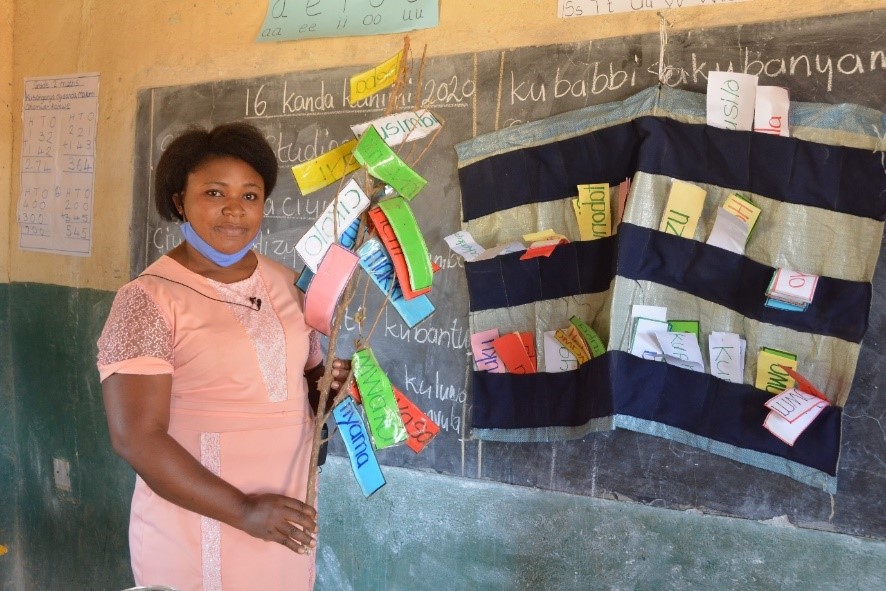
Local resources to support home-language literacy in a social studies lesson. Some of the photographs in this resource were taken during the COVID-19 pandemic in 2020 so face coverings and social distancing appear.
4. Supporting reading and writing across different subjects
As you read in the introduction to these training materials, supporting literacy doesn’t only take place in literacy or English lessons – all teachers can do it, whatever subject they are teaching. One thing that helps learners with literacy skills across the curriculum is having a classroom that is a print-rich environment.
What is a print-rich environment?
A learning environment can be the full school or a classroom. Imagine two learning environments. The first has nothing on the walls and no books. The second has walls with posters and pictures with words, and a ‘reading corner’ with books. This second example is a print-rich environment. Here is a photo of one such classroom.
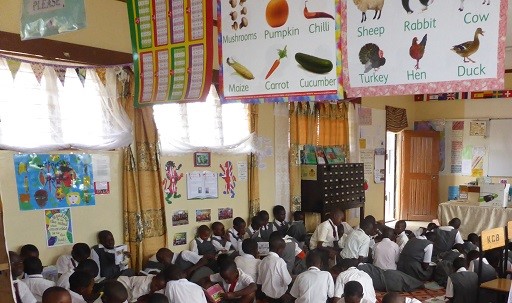
A print-rich classroom provides learners easy access to reading resources.
In a classroom which is a print-rich environment, pictures, posters, learners’ written work and other written resources help children to develop their skills by giving them things to read around them. It also makes them feel motivated to learn. So, what is in a print-rich classroom? It will have lots of different types of language in written form. As well as books, these things can include posters, food-packaging, pictures from old magazines or newspapers, maps, graphs, timetables and things that you or learners have written on pieces of card.
Try to change the displays regularly. New curriculum topics can be good opportunities to do this or you could create different corners for each subject area. Having a display with, for example, mathematical language can really help your learners.
Activity 5.5: Creating a print-rich environmentIn one school in Zambia, teachers hung activity envelopes on trees in the play area for children to explore during their breaks. These were extremely popular with the learners and are a great example of a print-rich school. Look around your school and think about the questions below. Write your responses in your Teacher Notebook and share them with your colleagues in the next TGM.
|
4.1. Using group work to support literacy
In the course 2 training materials, you focused on using group work in your classrooms. Group work can be a very effective way of helping learners with their literacy skills across different subjects. As well as helping each other, they will be much less anxious about making mistakes if they are working in small groups than when working alone.
Activity 5.6: Using writing from your local environment for group workThe following activity involves collecting examples of writing in the local environment as the basis for a simple reading and discussion activity in the classroom. Since most of the examples are likely to be in English, this would be a good activity for Grade 4 or above, but it can also be used to support social studies topics around ‘living in the community’ for Grades 1 and 2. You can find TESSA resources to help with this activity in Literacy Module 1, Section 3 and in Life Skills Module 2, Section 2. In the TGM, work with a colleague to make a list of writing from your local environment that your learners may be familiar with or find interesting. Look out for examples at home, on your journey to work and within the school grounds. These could be on signs, adverts, labels, packaging etc. Write the words or phrases that you have collected in large letters on strips of paper and fold them up. Begin by explaining to your learners what you have collected. Put the learners in small groups of three or four and give each group several folded strips of paper. You can do this randomly by getting groups to pick them from a container, or selectively by allocating strips according to your learners’ attainment levels (as teacher Rita did in Classroom Example 5.2). Ask the learners to unfold their strip/s and have a short discussion about where the writing might be found and what it means. Ask each group to then ‘show and tell’ their words to the class. As a follow up, you could give each of your learners a blank strip of paper and ask them to look for new words or phrases over the next week on their way home from school, in their home or in their neighbourhood. You can use these for a similar group activity or put them on the word wall for other learners to read and talk about. You can also ask your learners to bring into class any printed material they find in their home or village that is no longer being used and make a wall display from it. If you have access to a camera and printer, you could take close-up photos of examples of writing in your local environment and print out copies to display. You can also set up a collection box in the school where written materials of any sort can be dropped off for other teachers and learners to use. |
4.2. Assessing literacy skills
If you are a specialist teacher, you may find that some of your learners cannot read and write very well and need support with basic literacy to help them access the curriculum.
All teachers need to be aware of the literacy challenges that learners face, so it is important to create opportunities to assess literacy. This requires careful planning.
Activity 5.7: Teaching and assessing literacy skills across the curriculumIn your TGM, working with a partner, look at your teaching plans for next week.
|
When you have taught a lesson, it is important to reflect on how it went, so that you can adjust your plans in the future. Here are some questions you can ask yourself. Write the responses in your Teacher Notebook.
- Did this activity help children to develop their reading skills? If so, which aspects?
For example, vocabulary development, speaking and listening skills, and/or fine motor skills. - Did the children enjoy the activity?
- Did all the children take part in the activity?
- What would you do differently next time?

Teacher
including literacy through reading in the home language in a social studies
lesson.
5. Supporting reading and writing across different levels
In the previous activity (5.7), you focused on assessing literacy skills in all your lessons. The techniques you use will differ depending on the age of your learners. In the lower primary years, much of the focus will be on developing literacy in the home language. In higher grades, you will need to support learners to ensure they can read and write in English.
Classroom Example 5.3: Using local resources to support literacy in science
Listen to the audio or read the transcript. In your Teacher Notebook, makes notes of the activity teacher Samuel prepared to support literacy in Grade 3, and how teacher Paxina adapted the activity for her Grade 6 lesson. Audio transcript:
Teacher Samuel was teaching his Grade 3 class about animals and where they live. He teaches them in Chitonga. Only about 25 are confident readers out of the class of 76. He found pictures of six animals and stuck them up on the classroom wall. He then drew pictures of where they live and stuck those up on the other side of the room. He made some cards out of old food packets and wrote the name of an animal on half of them and the name of where they live on the other half (all in Chitonga). He gave half of the class the name of an animal and the other half the places where they live. To begin with each learner had to stand next to the picture corresponding to their animal or place. This was to check that all the children could understand the words they were given. They then had to walk around the room to find a partner who had the name of where their animal lived. For example, ‘gorilla’ was matched with ‘rainforest’; ‘worm’ with ‘mud’ and so on. When everyone was paired up, Samuel collected in the cards and gave them out again so everyone had a different word. He did this a few times until he was confident that all the children could recognise the words and they knew where each animal might live. At the next TGM, he explained his idea to the other teachers. Teacher Paxina was also doing science with Grade 6. She adapted the activity but wrote the words in English. Also, when the pairs had found each other, they had to discuss how their animal was adapted to where it lived. At the end, they had to write a sentence about each animal and why it lived in a certain place. |
|
Did you notice...
|
5.1. Using storybooks – supporting younger children
Using storybooks in your classes is a good way to involve all the learners in reading activities. There are different ways in which you can do this:
Shared reading: You read a story to the whole class. Show pictures if it is possible and talk about what the learners see, hear, think and feel. Follow up the reading with discussion and activities. You can set a particular time or day in the week where this takes place so that the learners become used to sitting, listening and participating.
Paired reading: Learners sit in pairs to read together or take turns to read a simple storybook that they can read themselves to each other.
Independent reading: On their own, learners read short, simple books that are easy enough for them to read without help.
You can use factual books as well as fiction to do the following activity with your learners.
Activity 5.8: Collaborating with othersChoose any story that you want to read with learners. Select a story that is good for asking questions about – questions which will make learners think. It could be from a book or a story you know well and can remember, or you could write or make up your own story. During the TGM:
In the classroom:
After the lesson:
|
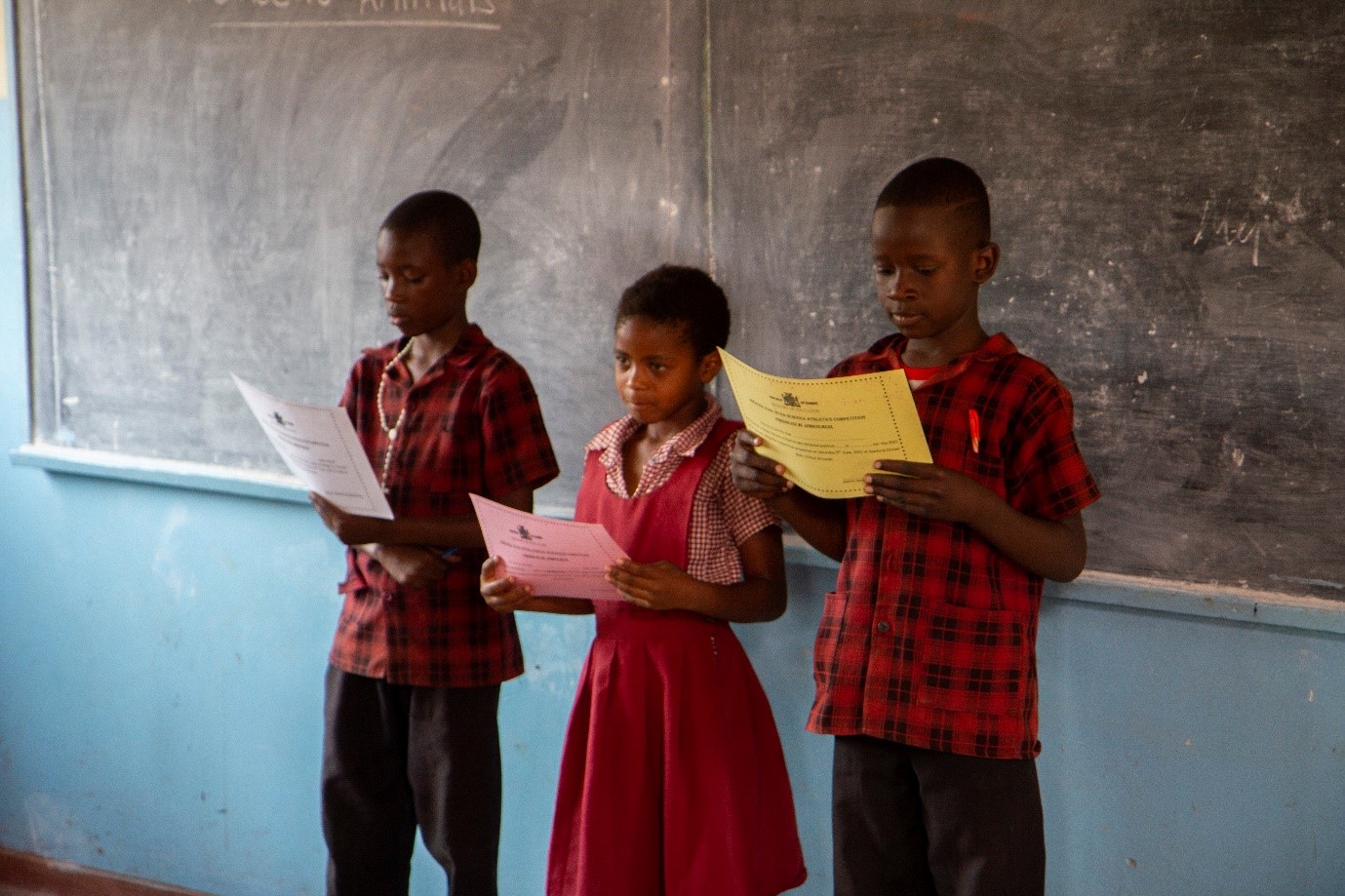
Learners telling a story to the class in Central Province, Zambia
You can also ask your learners to tell stories to the other children in your class.
Activity 5.9: Learners telling storiesWatch this Class 1 student telling a story (based on a traditional Zambian folktale) to her class. What does the teacher do to ensure that all the other learners are involved and listening to the story? Think about how you could use your learners as storytellers in your classroom and share ideas with your colleagues in the TGM. |
5.2. Supporting older learners with literacy
As learners progress through school, they are expected to read and write in different styles depending on the subject they are studying. It is important that learners in upper primary grades begin to understand how science and social studies use a different style of writing, for example. You can help your learners by introducing them to different types of text, for example, through science experiments, social studies reports etc.
Activity 5.10: Understanding syntax and synonymsThis is a lively activity for older learners. Use your time in the TGM to try it out on each other. Copy onto the board a short factual reading or paragraph of approximately four or five sentences that your learners have recently completed in one of their textbooks. Get a learner to read it aloud. Ask another learner to come to the front and erase all the adjectives. Then ask the class or a volunteer to read it aloud again including the now-missing adjectives. Ask another learner to erase all the nouns. Then ask the class or a volunteer to read it aloud again, including the now-missing adjectives AND nouns. Repeat with verbs, adverbs, articles, punctuation until there is virtually no text. You can then, if you want to, rebuild the paragraph using learners to come up and write in the missing sentences. Another way to use this activity could be to ask learners to replace the words with synonyms. For example, after you have removed all adjectives, ask learners to add a suitable synonym. |
6. Encouraging your learners to read

Reading corner in a school in Mumbwa district, Zambia.
Activity 5.11: Setting up a classroom reading corner for silent readingIn the TGM, read through the suggestions listed below for supporting reading. Work with a colleague to share ideas about what would work best in your school. Make sure you each commit to doing two of the things on the list. Here are some ideas from teachers who have been developing their book areas and libraries in school.
Ensure that your collection appeals to a range of levels of reading ability and not just your highest attainers. Include a variety of genres among the books available, such as:
Bookmaking Older learners can produce a book containing their own poems or stories. They could write a short play, develop a book about a topic that has been focused on in their lessons or write a book for younger readers. They can design a cover for their book to make others want to read it. |
7. Summary: Literacy across the curriculum
This course has provided a basis for continuing to develop learner-centred ways of working both in the classroom and with colleagues in your TGMs. Having worked your way through the course, why not revisit Activity 5.1 and review your own progress to support literacy and the actions at school level.
Activity 5.12: Reviewing school and personal action plans to support literacyActivity 5.1 invited you to: ‘In your Teacher Notebook, write:
You can make a poster of the three school actions to put in the staff room as a reminder for all teachers that literacy is everyone’s responsibility and to ensure you fulfil the actions by the end of term.’ Go back to those actions, and before the TGM, take some time to write your personal reflections on:
In the TGM, share your reflections and discuss whether you can see a change in your approach and the school’s outcomes in literacy? In the future, you could use one TGM at the end of the year to reflect specifically on the whole school approach to literacy and decide on what strategies to adopt in the following year to promote it with all teachers. |
Following the model in previous courses, the purpose of the final activities is to reflect on what you have learned and to complete a short quiz to demonstrate your understanding of the key concepts around supporting literacy across the curriculum.
Activity 5.13: Reflecting on your professional developmentOn your own, look back through your Teacher Notebook and make a summary of some of the main things you have learned in this course. What has helped you to learn? Are there any critical incidents that made a big impact on you? Think back to last term – write down any ways in which your lessons are different now. Discuss your reflections with a colleague and set yourselves three targets each for next month. Think about the things that you think you need to improve and what you can do to achieve that improvement. |
Activity 5.14: Reviewing your learning Quiz |

Learners in Mumbwa District, Central Province, Zambia
References:
TESSA: Teaching early reading in Africa – with African Storybook, developed by The Open University's Teacher Education in Sub-Saharan Africa (TESSA) programme in partnership with the South African Institute of Distance Education (SAIDE)'s African Storybook Initiative, with the generous support of the David and Elaine Potter Foundation.
https://www.open.edu/openlearncreate/course/view.php?id=3287
IGATE: Improving Girls access through transforming Education, The Open University and World Vision Literacy and Numeracy Modules